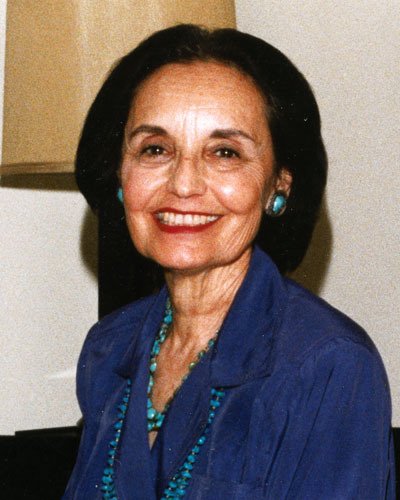
Share Your Memory of
Edna
Obituary of Edna Jasinski
Please share a memory of Edna to include in a keepsake book for family and friends.
Oklahoma Indian Ballerina Moscelyne Larkin dies.
Edna Moscelyne Larkin Jasinski died on Wednesday, April 25, 2012 in a Tulsa nursing home following an extended illness.
It is with great sadness that Tulsa Ballet announces the death of its co-founder, Edna Moscelyne Larkin Jasinski ("Moussia.") With Miss Larkin's death a vivid era in the formation of Tulsa's arts organizations closes.
Miss Larkin and her husband, Roman Jasinski, were the breath and soul of the early Tulsa Civic Ballet and their former students throughout the world are testaments to their talent, technique, and artistic training.
Miss Larkin (who danced under the stage name "Moussia Larkina" or "Moscelyne Larkin") was admired throughout her professional career for her on-stage magnetism and her exceptional leaps and turns. She excelled in roles that required charm, speed, and virtuosity.
Born January 14, 1925 in Miami, Oklahoma to a Russian-born mother, Eva Matlagova, and a Shawnee Peoria / Welsh father, Reuben Francis "Babe" Larkin, Miss Larkin remained proud of her dual cultural heritage and her Oklahoma roots throughout her life.
At the age of 13, after training with her mother, the talented young dancer moved to New York City to study with Celli, Mordkin and Vilzak-Shollar. The legendary choreographer Michael Fokine, fascinated by her talent and exotic looks, choreographed a studio piece for her, and Mordkin stopped his class one day to say to her, "You're a little fish now, but one day you're going to grow up and be a big fish and you're going to eat up all the other fish."
At the age of 15 1/2 Larkin skipped school to audition for Colonel de Basil's Original Ballet Russe and was immediately accepted into the corps de ballet. Within days she met principal dancer Roman Jasinski and three years later she married him. It was a marriage that would last for forty years until he predeceased her in 1991.
A natural linguist, Larkin mastered the Russian spoken in the Company, Spanish from years of touring South America, and smatterings of French, but her husband's native Polish remained a lifelong challenge. Because the Ballet Russe spent the years of World War II in South America, those years became, for Miss Larkin, both an extended honeymoon and an educational emersion into the history and legacy of dance. She considered them the best years of her life.
Bit by bit she performed new roles, rising ever higher on the Ballet Russe ladder. Favorite roles from that period were the 'Waltz' in Les Sylphides, 'Guile' in Paganini, the dance competition in Graduation Ball and the 'Blue Bird" pas de deux from Aurora's Wedding.
In 1947, at the end of a tour to Europe where a London critic termed Larkin "...the first ray of sunshine after the war," the Jasinskis left the Original Ballet Russe and returned to America with no job, no plans. "It was time."
Filling the employment gap, Larkin danced four full performances a day (rehearsing between performances) as Prima Ballerina at the Radio City Music Hall, and she was one of the first dancers to perform regularly on television, dancing for six months on the weekly Fay Emerson show to the baton of orchestra leader Skitch Henderson.
In 1948 Jasinski joined Serge Denham's Ballet Russe de Monte Carlo as a principal dancer, and Larkin joined the company at the beginning of the following season. She added new roles to her repertoire, among them the 'Cowgirl' in Rodeo (she was choreographer Agnes de Mille's preferred dancer for that part), 'Zobeïde', in Schéhérazade, 'the Young Girl' in Massine's Beau Danube and lead roles (Cancan, 'Glove Seller') in Gaité Parisienne.
In 1952 Denham asked Jasinski to head a small Ballet Russe de Monte Carlo Concert Company with a few principals and corps members. This company made U.S. history by bringing ballet to college campuses and Small Town America. Miss Larkin was one of the ballerinas, a role she gave up a year later when she became pregnant. Their son, Roman Larkin Jasinski, was born in Tulsa February 21, 1954.
By then Miss Larkin's mother had a thriving ballet school in Tulsa, so after private tours with Russian ballerina Alexandra Danilova to the Philippines, Japan, Panama, and throughout the U.S., the Jasinskis decided to retire to Oklahoma, join Matlagova's studio, and raise their son.
They were part of the professional exodus from major dance centers that enabled talented students to stay in their home towns and receive top professional training. The Jasinskis, however, carried that training further.
In 1956 they pulled together a few talented students from several Tulsa studios, and, as principal dancers, led a performance at Temple Israel. The response was so positive, that they and pianist Rosalie Talbott incorporated Tulsa Ballet Arts a few months later. This was the company that would ultimately become today's fully professional, internationally-acclaimed, Tulsa Ballet.
In 1957 the Jasinskis masterminded the first "Oklahoma Indian Ballerina Festival." Larkin, Yvonne Chouteau, Maria Tallchief and Rosella Hightower, all of Oklahoma Indian heritage, performed excerpts from Swan Lake, Giselle, and other ballets, augmented by the local corps de ballet. Only Marjorie Tallchief was absent.
By 1967 Yvonne Chouteau and her husband, Miguel Terekhov, now living in Oklahoma City, joined the Jasinskis in producing the second festival. In this, Marjorie performed. {Maria had already retired.) Both Festivals were the subject of laudatory articles throughout the U.S. and Europe that brought artistic accolades to the young state of Oklahoma.
Soon stars from American Ballet Theatre, New York City Ballet and other stellar companies were flocking to Tulsa, Oklahoma to receive personal coaching from the Jasinskis in the Ballet Russe repertoire, and to perform with the local company.
Roman Jasinski began to build his choreographic talents, Miss Larkin proved herself a demanding and inspirational teacher / coach, many of their young student-dancers were accepted into the country's most prestigious companies, and the fledgling Tulsa Ballet began to be noticed throughout the nation as a worthy successor to Ballet Russe technique, artistry and repertoire.
When the Jasinskis arranged for the revival of lost or little-known works from Balanchine, Fokine, Massine, and other great choreographers of the past, the ballet world took immediate and appreciative notice.
In 1978 Miss Larkin was inducted into the Oklahoma Hall of Fame. Later, she was given the Governor's Arts Award, and named "Outstanding Indian" by the Council of American Indians--an honor she treasured. Together they were given the Lifetime Achievement Award from the Tulsa Arts and Humanities Council; inducted into the Tulsa Hall of Fame, and received honorary degrees from the University of Tulsa. Beyond doubt, their highest professional accolade came in 1988 when they were presented the annual Dance Magazine Award for their "shining example" in creating a major mid-American company in the classical tradition where none had existed before.
The partnership ended in 1991 with the death of Jasinski, but Larkin carried on as Artistic Director Emerita of Tulsa Ballet, and teacher, with her son Roman, at their Jasinski Academy. Always conscious of her Native American heritage, she made a special effort to encourage and promote the education and advancement of Native American children.
She is survived by her son, Roman Larkin Jasinski of Tulsa and her deceased brother Lloyd's children and grandchildren.
She was preceded in death by her parents, her brother, Lloyd George Larkin and her husband, Czeslaw Roman Jasinski on April 16, 1991.
Donations in her memory may be made to the Alzheimer's Association 2448 E. 81st St., Suite 3000,
Tulsa, OK 74137




